
Designing a shared bedroom for kids can feel like an impossible puzzle. You want the space to be stylish yet practical, personal yet cohesive, and most importantly—spacious (or at least feel that way). But how do you fit two (or more) kids, their belongings, and their ever-changing interests into a single room without making it look like a storage closet exploded?
I remember the first time I had to share a bedroom as a child. My brother and I had very different ideas about what our dream room should look like. He wanted dinosaurs, I wanted stars. He needed bright colors, I preferred soft neutrals. And the space? Tiny. Our parents did their best, but let’s just say “organized chaos” became our aesthetic.
Fast forward to today, and kids’ shared bedroom designs have come a long way. From sleek modern layouts to space-saving furniture and smart storage solutions, there are endless ways to create a room that feels open, stylish, and practical. Whether you’re designing for a brother and sister, two sisters, or even a tiny toddler duo, this list of modern kids’ shared bedroom ideas will give you all the inspiration you need to make the most of the space—without the sibling squabbles.
1. Bunk Beds With A Modern Twist: Space-Saving & Stylish

Bunk beds have been the ultimate space-saver for shared kids’ rooms for generations, but today’s designs take them to a whole new level. Forget the clunky wooden frames of the past—modern bunk beds come in sleek metal, minimalist Scandinavian wood, and even built-in designs that seamlessly blend into the room’s architecture.
For a truly spacious feel, opt for a bunk bed with an open-frame design. These allow more light to flow through the room, making it feel airy rather than cramped. If your space allows, consider L-shaped or perpendicular bunk beds. These provide a more dynamic layout, freeing up space underneath for a desk, play area, or extra storage.
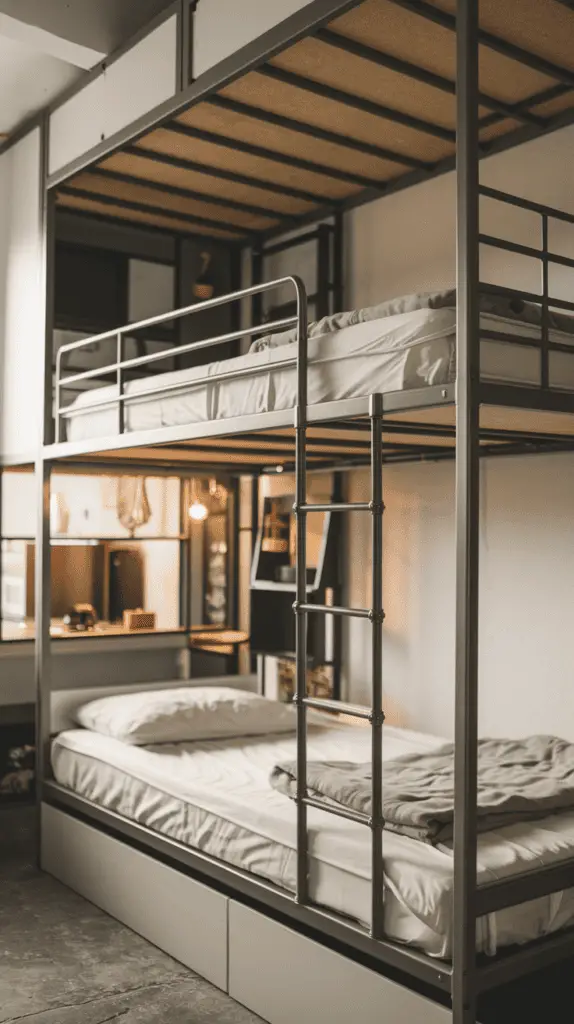
Storage is another game-changer. Many modern bunk beds now come with built-in drawers, cubbies, and even hidden compartments for keeping toys and clothes neatly tucked away. If you’re designing a shared bedroom for a boy and a girl, opt for a neutral-colored bunk bed that fits both personalities—think soft gray, warm beige, or a subtle two-tone design.
Worried about fights over the top bunk? A little negotiation trick: let the kids swap spots every few months. Suddenly, that bottom bunk won’t seem so bad after all.
2. Small But Mighty: Maximizing A Tiny Shared Kids’ Room
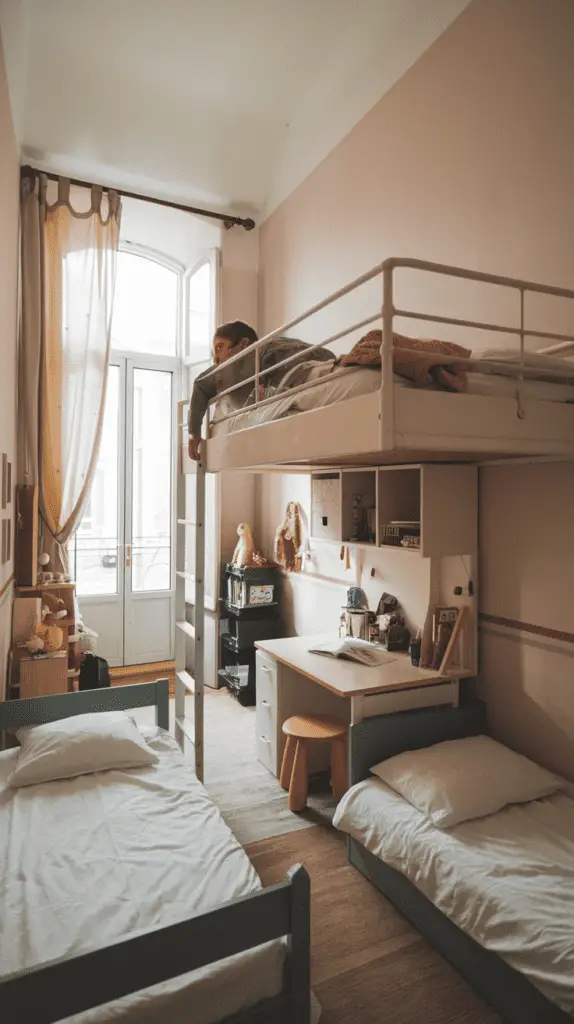
A small shared kids’ room doesn’t mean sacrificing comfort or style—it just means getting creative. First, embrace multi-functional furniture. Beds with drawers underneath, wall-mounted desks, and fold-away study spaces can help free up floor space while still providing everything your kids need.
When designing a small bedroom for two sisters or a brother and sister, consider a loft bed. One child can sleep on top, leaving the space below open for the second bed, a play area, or a built-in wardrobe. Another great trick? Vertical storage. Floating shelves, pegboards, and tall, slim wardrobes keep the room organized without taking up valuable space.
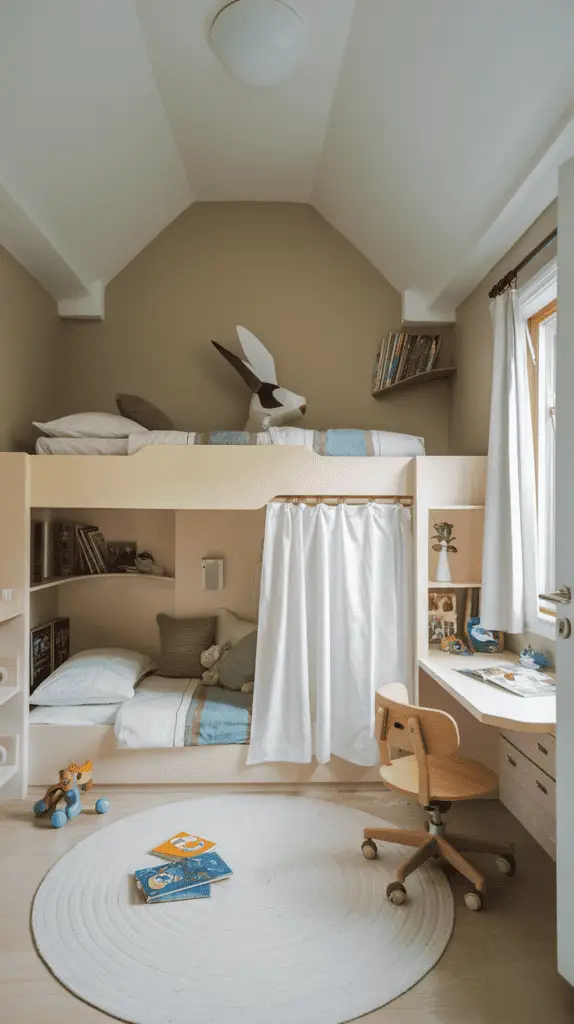
Color also plays a key role. Lighter shades like soft pastels, warm whites, and muted neutrals make the room feel more open. And don’t underestimate the power of mirrors—strategically placing one across from a window can instantly make the room feel bigger.
Finally, if the kids need their own defined space, use a shared room divider like a curtain, a low bookshelf, or even a decorative screen to give them a sense of privacy without closing off the room completely.
3. A Stylish Shared Girls’ Bedroom: Soft Hues & Playful Elegance

Designing a shared girls’ bedroom doesn’t mean covering everything in pink (unless, of course, they want that!). A modern take on girls’ bedroom ideas for two beds includes soft, neutral palettes, natural wood accents, and whimsical elements that feel both cozy and elegant.
A neutral twin bedroom works well for sisters with different tastes—think creamy whites, soft sage greens, or gentle peach tones. Add texture with linen bedding, a chunky knit throw, or a rattan pendant light. To keep things organized, opt for matching storage baskets, under-bed drawers, or built-in shelving that blends seamlessly into the room’s design.
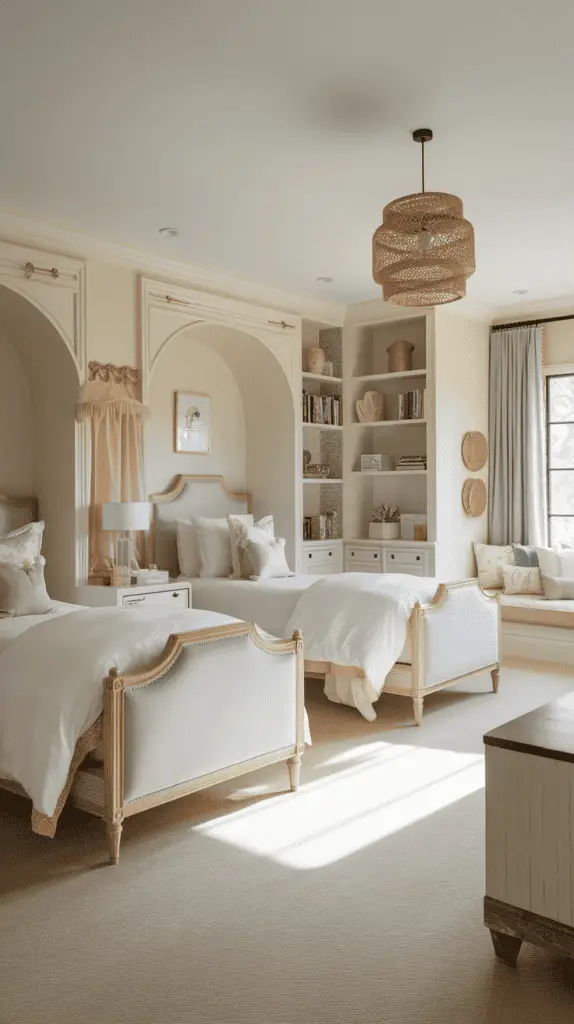
For the beds, symmetrical twin beds with matching headboards create a chic, balanced look. Want to add some personality? Let each child choose their own bedding color while keeping the base decor cohesive.
A dedicated play or reading nook can also help the room feel less cluttered. A cozy canopy over a floor cushion, a mini teepee, or a floating bookshelf filled with their favorite books adds a fun and practical touch.
4. The Perfect Brother & Sister Shared Bedroom: Balance & Harmony
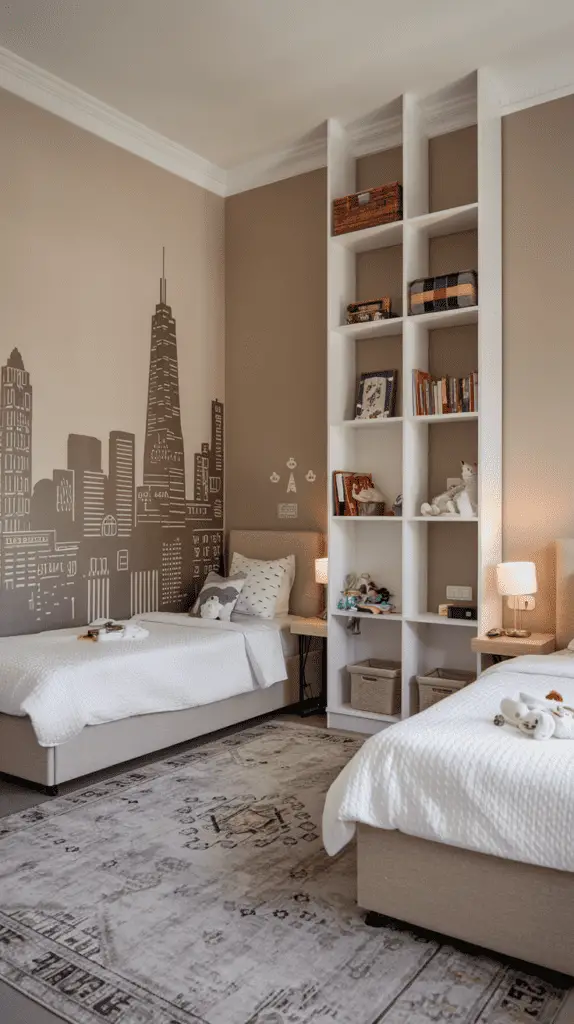
When designing a brother and sister shared bedroom, the biggest challenge is blending two distinct personalities into one cohesive space. The trick? A neutral base with pops of their individual styles.
Start with a gender-neutral color palette—think warm beige, soft grays, or pale blues. Then, let each child add their own personal touches. This could be bedding in their favorite color, individual wall art above their beds, or separate storage bins in fun shades.
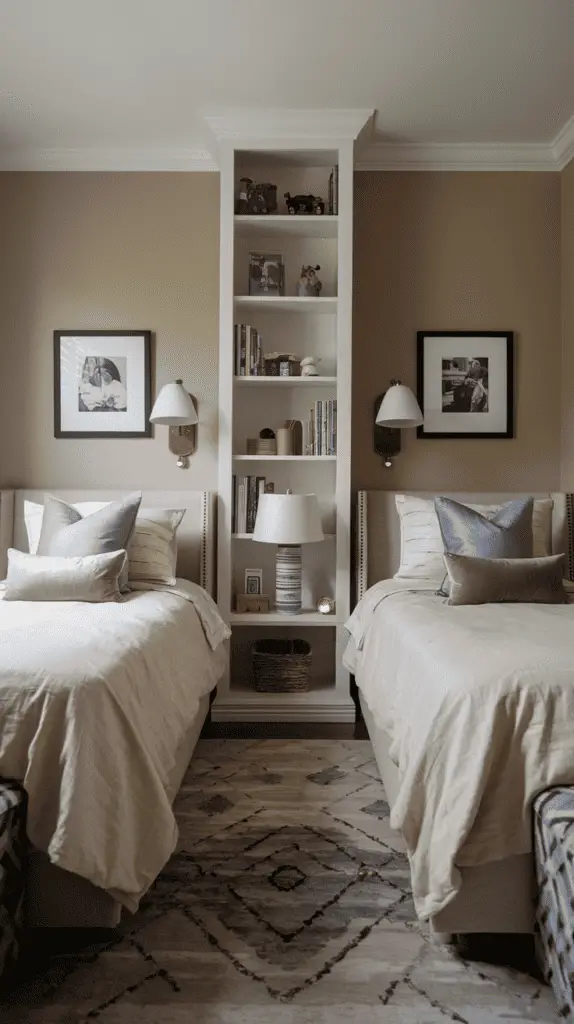
A great way to create defined spaces is by using a shared bedroom divider idea, such as a low bookcase, a partial room divider, or even color zoning—painting one half of the wall in one shade and the other in another.
For beds, twin beds with a sleek, minimalist frame work well. If space is tight, a bunk bed is still a solid option, but consider one with a divider curtain for extra privacy.
And let’s not forget lighting! Separate bedside lamps or wall sconces allow each child to control their own light, perfect for those “but I’m not tired yet!” bedtime battles.
5. Making A Small Shared Kids’ Room Feel Like A Dreamy Retreat

No matter the size, a small shared kids’ room can be turned into a cozy and dreamy retreat with the right design choices. Start by making the most of natural light—sheer curtains, white or pastel wall colors, and minimal furniture help keep the space open and airy.
Instead of traditional beds, consider kids’ bedroom 2-bed designs with slim-profile frames or even wall-mounted Murphy beds for maximum space-saving. Another great option is a daybed that doubles as a sofa during the day.
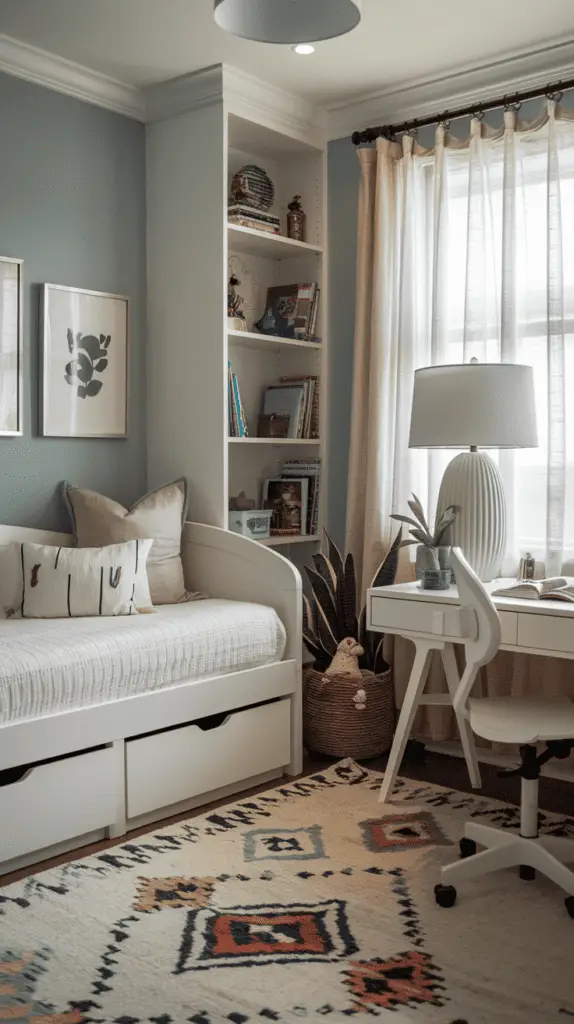
Storage is key to maintaining a spacious feel. Opt for hidden storage solutions like beds with built-in drawers, floating shelves, or an ottoman that doubles as a toy chest. If you’re splitting a bedroom in two, use soft dividers like a bookshelf, a canopy, or even a stylish floor rug to create separate zones.
Finally, let the kids’ personalities shine through! A mix of artwork, fun wallpaper on one accent wall, or even a DIY gallery featuring their own drawings can make the room feel special and unique without overwhelming the space.
6. Creative Room Dividers: Splitting A Shared Space Without Walls
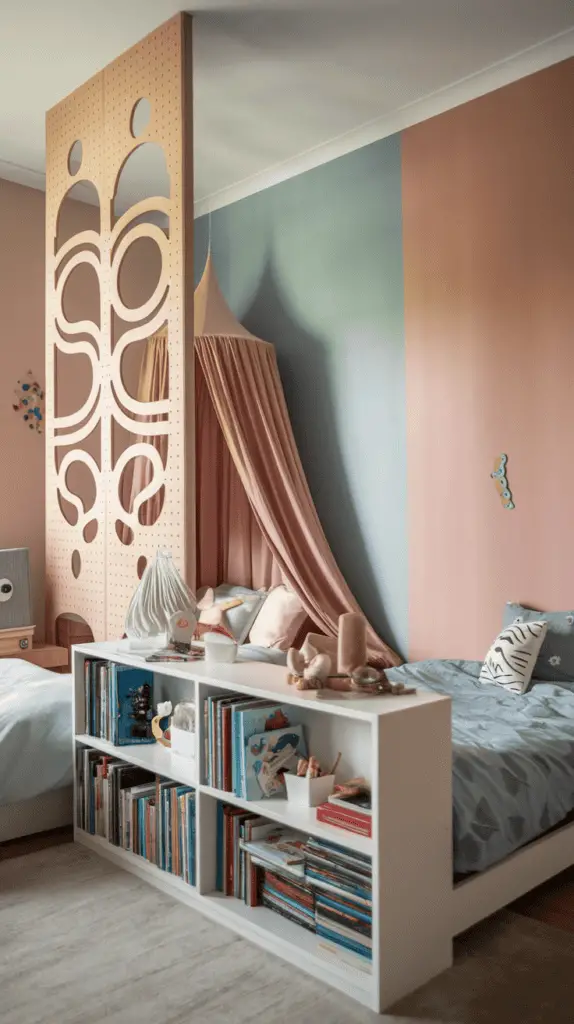
One of the biggest challenges in a shared kids’ bedroom is creating personal space for each child. While building an actual wall isn’t always an option, there are plenty of clever shared room divider ideas that help define each child’s area while keeping the room open and airy.
A low bookshelf is a simple yet effective way to separate sleeping areas while adding extra storage. For a softer approach, a canopy or a sheer curtain hung from the ceiling can create a cozy, semi-private nook for each child without making the room feel smaller. Another stylish option is a decorative wooden slat partition, which adds a modern touch while allowing light to filter through.

For kids who love to decorate their own space, a pegboard divider works wonders. They can hang small shelves, hooks, or even fairy lights to make it feel like their own little world. If you’re designing for a brother and sister shared bedroom, consider a two-tone paint technique—one side in soft blue, the other in warm blush—to create a visual distinction between their halves of the room.
Remember, the key is to maintain flexibility. A lightweight divider on wheels, a fabric screen, or even a tall plant arrangement can give kids the privacy they crave while keeping the room adaptable as they grow.
7. Twin Beds Done Right: A Balanced & Stylish Layout
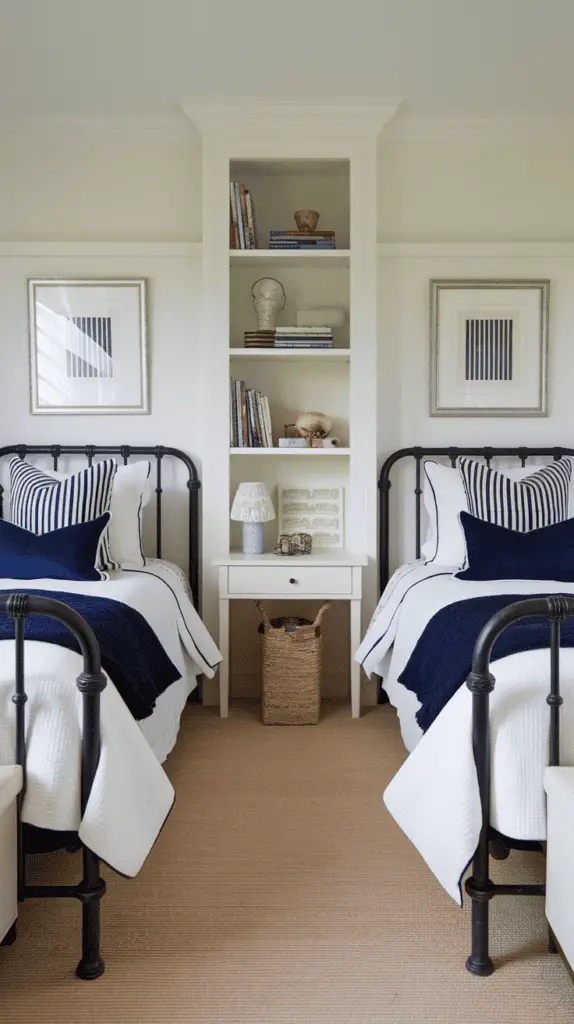
If you have enough space for separate beds, twin beds in a kids’ shared bedroom can create a visually appealing and practical setup. Unlike bunk beds, twin beds allow for more symmetry and design flexibility, making them ideal for both sisters and brothers sharing a room.
The trick is in the layout. Placing the beds parallel with a shared nightstand in between keeps things neat and functional. If the room is longer than it is wide, consider a head-to-head layout with a storage unit or desk separating the beds. A mirrored setup, where each side of the room reflects the other, also creates a cohesive, balanced look.

For a neutral shared bedroom, keep the bed frames simple and let the bedding and accessories bring personality. Matching headboards in a soft linen fabric, cozy layered blankets, and complementary color palettes (like navy and mustard, or blush and sage) make the space feel well-designed without looking overly themed.
If you’re working with a tiny bedroom, opt for twin beds with built-in storage underneath. Some models even have hidden pull-out desks, perfect for school-age kids who need a study space. Keeping clutter at bay with floating shelves and multifunctional furniture ensures that even a small twin-bed layout feels spacious and inviting.
8. Lighting Magic: Creating The Right Mood In A Shared Kids’ Room
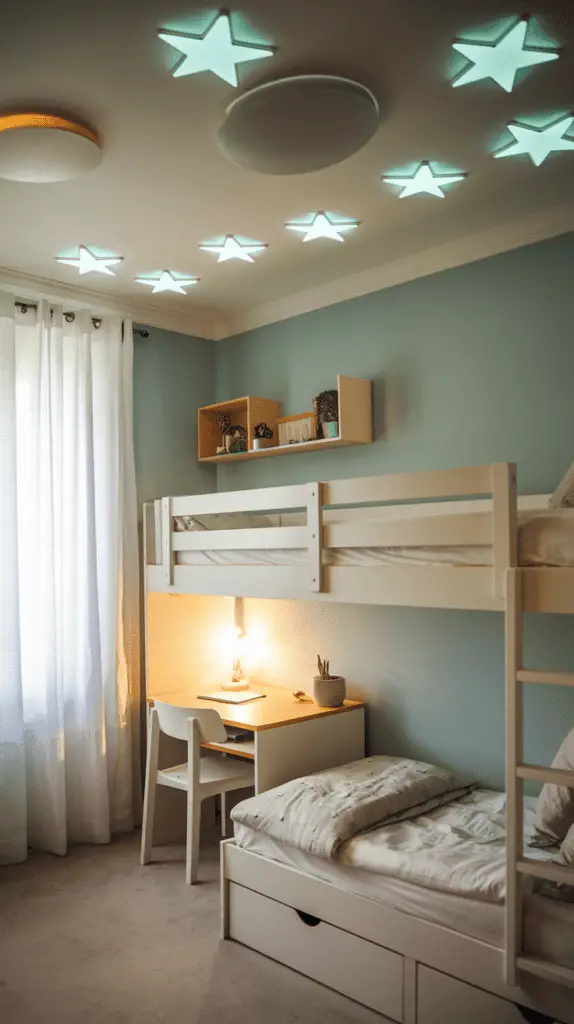
Lighting is one of the most overlooked aspects of a kids’ shared bedroom, yet it can completely transform how spacious and cozy the room feels. A mix of ambient, task, and accent lighting keeps the space functional and inviting.
Start with a central ceiling light—modern options like rattan pendants, sleek flush mounts, or whimsical cloud-shaped lights add charm without taking up valuable space. Next, layer in mood lighting with LED strip lights along the bed frame, warm fairy lights draped over a canopy, or even smart bulbs that change color depending on the time of day.

For reading and studying, individual wall-mounted sconces or small clip-on lamps give each child their own light source without disturbing their sibling. If you’re designing a small bedroom for two sisters, consider stringing delicate twinkle lights along a soft fabric headboard to create a dreamy, feminine atmosphere.
A fun and functional touch? Glow-in-the-dark star decals on the ceiling. They make bedtime more exciting and add a soft glow to the room at night without the need for a bright nightlight.
9. Playful & Practical Storage Solutions: Keeping Clutter Under Control

No matter how beautifully designed a kids’ shared bedroom is, it won’t feel spacious if it’s cluttered. The right storage solutions make all the difference in keeping everything neat while maximizing floor space.
Under-bed storage is an easy win—opt for beds with built-in drawers or sliding bins to keep toys, clothes, and books hidden but accessible. Wall-mounted storage, like floating shelves, pegboards, or even a hanging fabric organizer, keeps essentials within reach without taking up floor space.
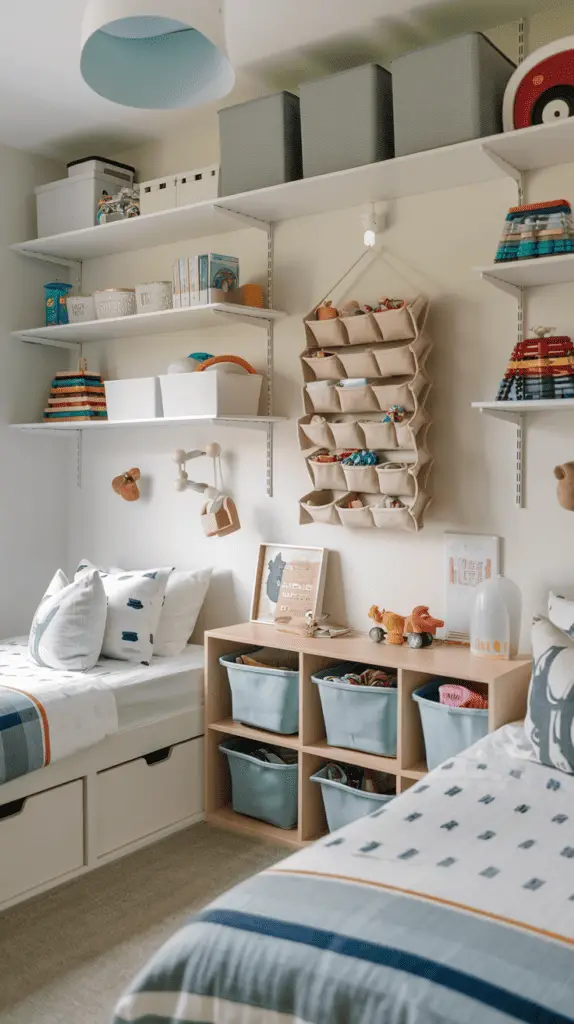
For shared rooms with different age groups, modular storage works best. Stackable bins, labeled baskets, and cubby shelves allow each child to have their own designated space for their belongings. If you’re designing for a brother and sister shared bedroom, color-coding storage boxes in their favorite hues makes organization more fun.
A genius tip? A toy rotation system. Store some toys away and switch them out every few weeks—this keeps the room tidy while making old toys feel new again.
10. Teen Bedroom Makeover: A Stylish Shared Space For Growing Kids
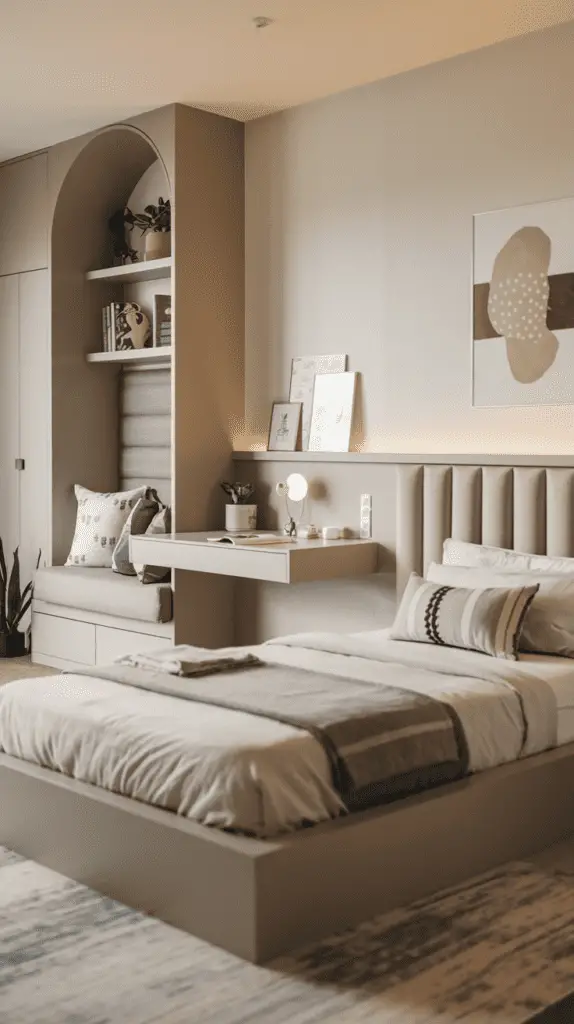
As kids grow into their teenage years, their needs change—so should their shared bedroom. A teen bedroom makeoverinvolves creating a space that balances personality, function, and independence.
Instead of bright primary colors, opt for a sophisticated neutral palette like muted greens, deep blues, or warm terracottas. Upgrading the furniture is another step—sleek platform beds, ergonomic study chairs, and compact wall-mounted desks make the room feel more mature while saving space.
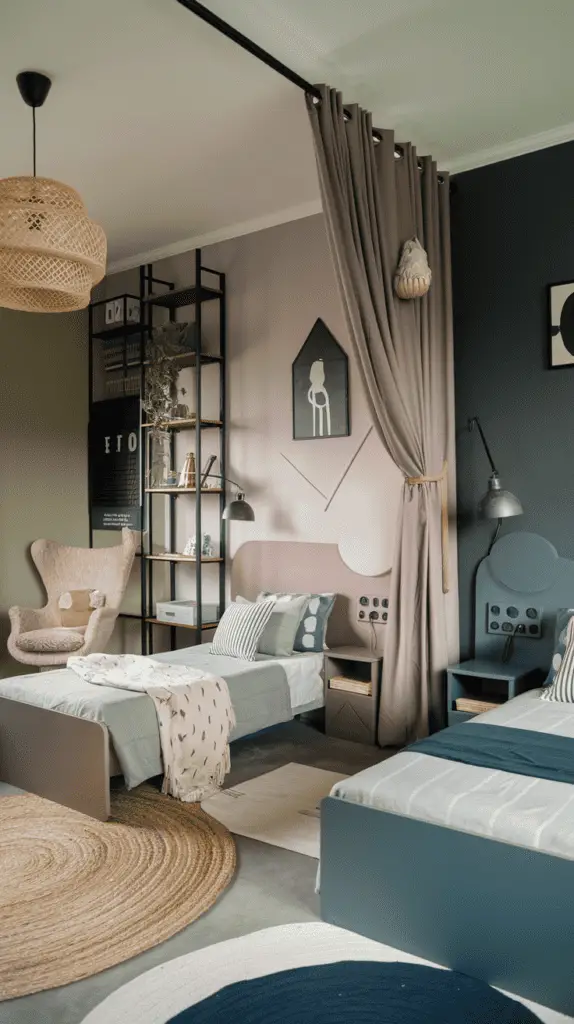
If the teens have different interests, a split design works well. One side of the room can have a boho aesthetic with warm textures, while the other might lean toward a modern industrial vibe with metal and monochrome tones. A shared room divider like a stylish curtain or a floating bookshelf keeps the space feeling distinct but cohesive.
Personalization is key—let each teen add their own artwork, mood boards, or framed posters above their bed. And since technology is a big part of their lives, add functional elements like a charging station, built-in USB outlets, or a small media corner for their favorite gadgets.
Final Thoughts
Designing a modern kids’ shared bedroom that feels spacious is all about making smart use of space while allowing each child’s personality to shine. Whether you’re working with a small shared kids’ room, a brother and sister shared bedroom, or a teen bedroom makeover, the key is to blend style with functionality.
Bunk beds and twin layouts maximize space while keeping things stylish, clever shared bedroom divider ideas create personal zones without making the room feel cramped, and thoughtful lighting and storage solutions ensure that the space remains cozy and clutter-free.
Most importantly, involve the kids in the process! Let them choose their favorite colors, themes, or little details that make the room feel special to them. When a shared bedroom is designed with creativity and practicality in mind, it becomes more than just a sleeping space—it’s a haven for play, relaxation, and happy childhood memories.
